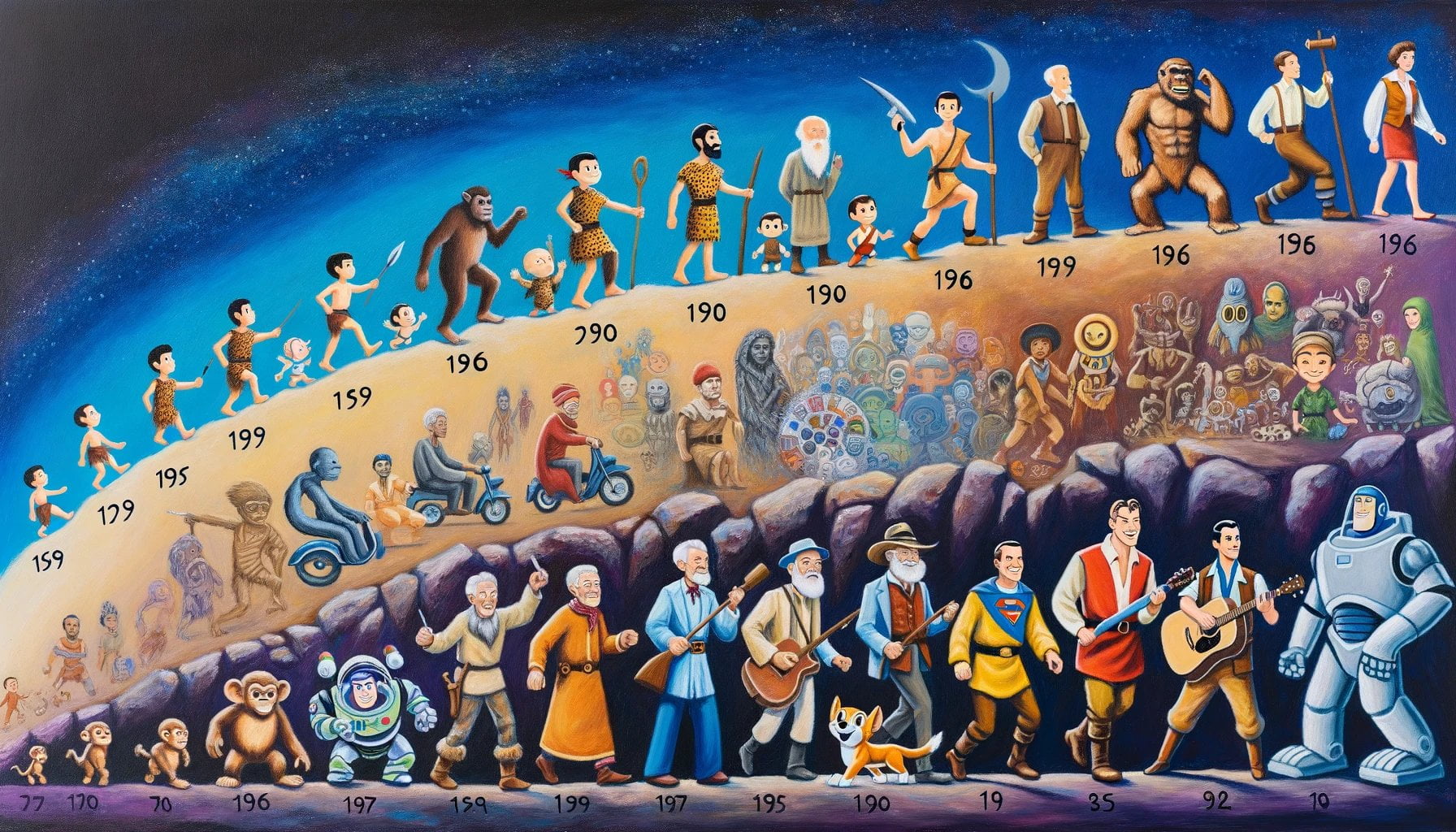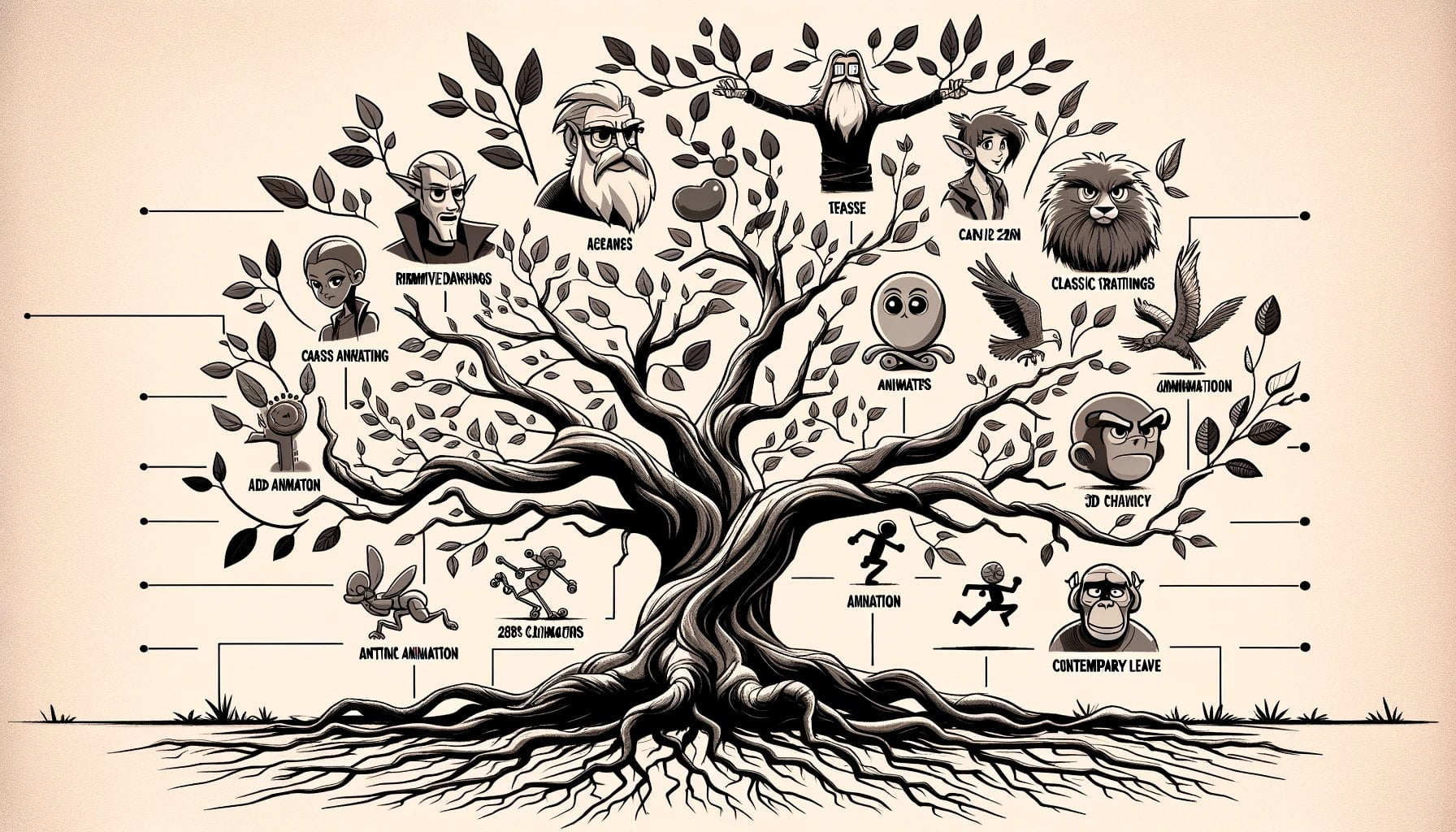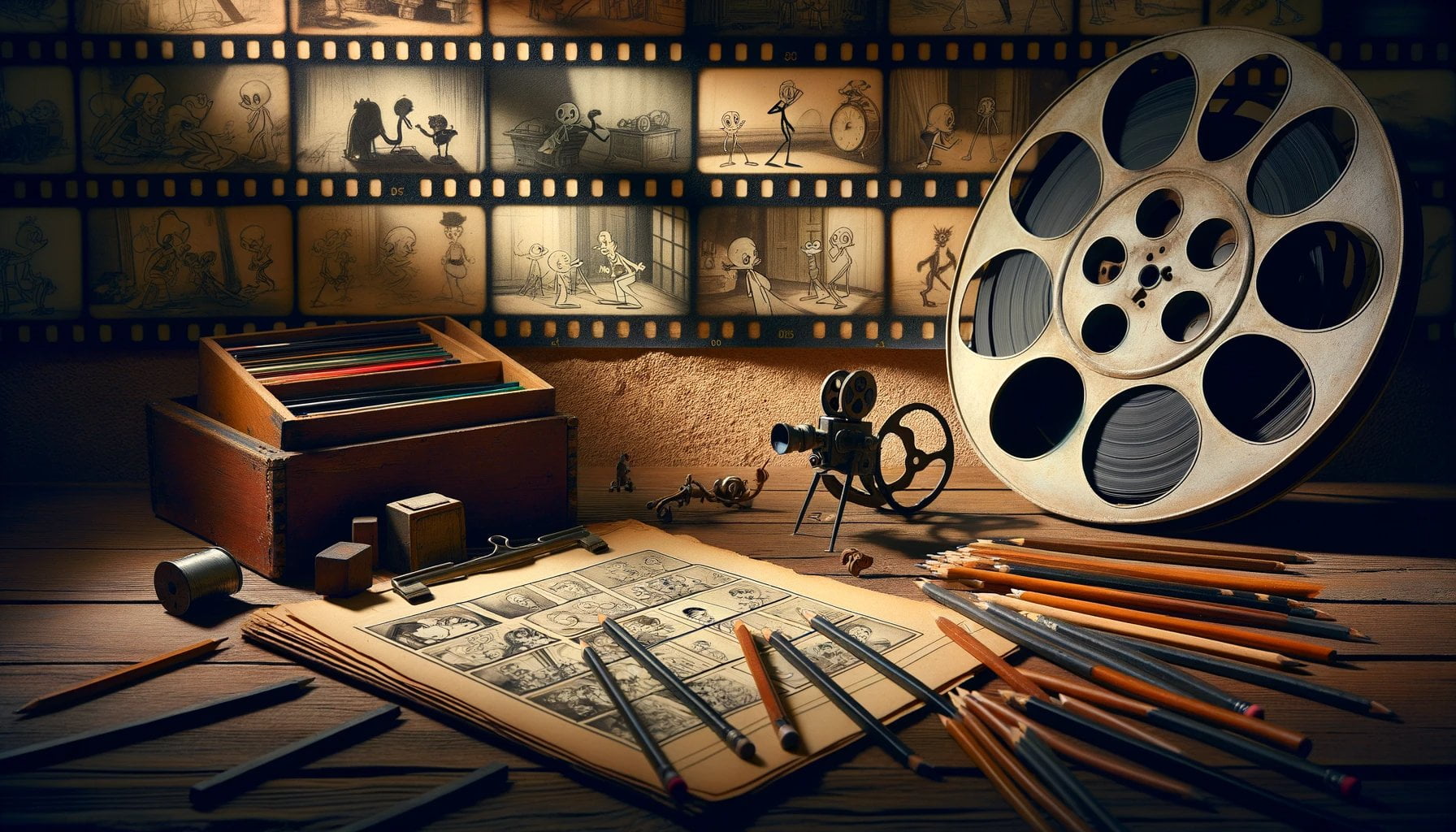Get ready to embark on a captivating journey through the evolution of animation, from its humble beginnings to the awe-inspiring digital landscapes we see today. This exploration will delve into the milestones, pioneers, and groundbreaking techniques that have shaped the magical world of animation, appealing to both seasoned animators and casual cartoon enthusiasts.

Animation History
The story of animation began in the late 19th century, coinciding with the invention of celluloid film. This innovation paved the way for a new era of storytelling and visual entertainment. Early animators experimented with bringing still images to life, leading to the development of two fundamental techniques: stop-motion and hand-drawn animation.
Stop-motion involved painstakingly moving objects in small increments, capturing each movement frame by frame to create the illusion of motion. Hand-drawn animation, on the other hand, relied on skilled artists who meticulously drew and photographed sequences of images, each slightly different from the last, to breathe life into their characters.
The period between the 1910s and 1930s, often referred to as the “Golden Age of Animation,” witnessed the emergence of major animation studios and a surge in the production of cartoons and animated films. This era was marked by continuous innovation, introducing color, synchronized sound, and the groundbreaking concept of full-length animated feature films, with Disney’s “Snow White and the Seven Dwarfs” (1937) standing as a prime example.
The mid-20th century saw the rise of computer animation, or CGI, as we know it today. Computers empowered artists with sophisticated tools to create detailed shading, three-dimensional effects, and limitless possibilities for visual storytelling.
Here’s a closer look at the key players in the animation world:
- Stop-motion: This technique involves taking a picture, slightly adjusting an object’s position, taking another picture, and repeating this process. When played back rapidly, these images create the illusion of movement. Claymation, a popular form of stop-motion, utilizes this technique to bring malleable characters and worlds to life.
- Hand-drawn animation: This classic technique involves artists drawing each frame by hand, traditionally on paper but increasingly with digital tablets. This method captures the fluidity and expressiveness of movement, giving animators great control over their characters’ actions and expressions.
- Computer-Generated Imagery (CGI): CGI leverages the power of computers and specialized software to create characters, environments, and entire worlds digitally. This technique allows for unparalleled realism and detail, as seen in popular Pixar films.
Animation continues to evolve, pushing technological boundaries and captivating audiences worldwide. Today, we encounter animated content on our smartphones, interactive animations in video games, and a constant stream of new techniques emerging from the creative minds of animators.
The history of animation is a fascinating journey, starting from the early days of 2D animation to the revolutionary world of computer animation. Learn all about it by exploring our animation history timeline. animation history timeline
Computer animation has come a long way, revolutionizing the way we watch movies and TV shows. Dive into the captivating world of computer animation history and discover how it has shaped the entertainment industry. computer animation history
Clay animation has a unique charm that has captured the hearts of audiences for decades. Uncover the secrets behind this captivating art form by delving into the rich history of clay animation. clay animation history
Japanese animation, also known as anime, has a rich and storied history that has influenced the global animation industry. Immerse yourself in the captivating world of Japanese animation history and unlock the magic behind its enduring popularity. japanese animation history
3D animation has changed the way we experience movies, bringing characters and worlds to life like never before. Delve into the dynamic world of 3D animation history and discover the groundbreaking techniques that have redefined the visual storytelling landscape. 3d animation history
2D animation has a timeless appeal that continues to captivate audiences, even in the era of 3D animation. Explore the enchanting world of 2D animation history and uncover the artistry and creativity that goes into bringing hand-drawn characters to life. 2d animation history

Who First Invented Animation?
Tracing the origins of animation is akin to searching for the first spark that ignited a wildfire. While attributing this invention to a single individual is challenging, evidence suggests that the pursuit of simulating motion through images predates modern technology by centuries. Ancient cave paintings with animals depicted with multiple legs, for example, suggest early attempts to convey the concept of movement.
The invention of celluloid film in 1888 marked a pivotal turning point, providing a medium for capturing and projecting moving images. However, even before this breakthrough, devices like the phenakistoscope (1832) and the zoetrope (1834) captivated audiences with the illusion of motion using spinning discs and sequential drawings.
French artist Émile Cohl is widely recognized for creating the first true animated film, “Fantasmagorie,” in 1908. Cohl’s groundbreaking work utilized stop-motion techniques, meticulously photographing thousands of individually drawn images to create a seamless flow of motion. His innovative approach laid the foundation for the development of animation as a distinct art form.
Cohl wasn’t alone in his pursuit. Other pioneers, including J. Stuart Blackton and Charles-Émile Reynaud, were simultaneously exploring the possibilities of animation. Blackton is credited with incorporating the first animated sequence in his 1906 film “Humorous Phases of Funny Faces,” while Reynaud’s Théâtre Optique projected hand-painted animations, captivating audiences with longer and more elaborate narratives.
While pinpointing the sole inventor of animation remains a point of contention, it’s clear that the late 19th and early 20th centuries witnessed a convergence of creativity, innovation, and technological advancements that propelled animation into the realm of possibility.
Who Was the Father of Animation?
The title of “father of animation” is often bestowed upon Émile Cohl, and for good reason. Cohl’s pioneering work in the early 20th century left an indelible mark on the development of animation. Although animation’s roots extend further back, Cohl’s contributions solidify his place as a central figure in its evolution.
In 1908, Cohl released “Fantasmagorie,” a groundbreaking film that utilized stop-motion techniques to bring hand-drawn images to life. This innovative approach, involving photographing thousands of slightly altered drawings, resulted in a fluidity and whimsy that captivated audiences. Cohl’s unique style, characterized by transforming shapes and whimsical narratives, set the stage for the development of animation as a distinct art form, influencing generations of animators to come.
Cohl’s contributions weren’t limited to his technical innovations. His use of humor, surrealism, and imaginative storytelling, evident in films like “Fantasmagorie” and “The Puppet’s Nightmare” (1908), helped establish animation as a medium capable of evoking a wide range of emotions. His work demonstrated that animation could transcend the limitations of live-action filmmaking, offering a canvas for boundless creativity and imaginative storytelling.
While Cohl’s contributions are undeniable, it’s important to acknowledge the contributions of other pioneers who shaped the early landscape of animation. J. Stuart Blackton’s experiments with stop-motion and Charles-Émile Reynaud’s Théâtre Optique, a precursor to projected film animation, highlight the collaborative spirit and rapid evolution of animation during this era.
What Is the History of Animation Art Style?
The evolution of animation art style is a testament to the medium’s dynamism, mirroring technological advancements, cultural shifts, and the boundless creativity of artists. From the simple line drawings of early cartoons to the hyperrealistic CGI characters of today, animation styles have continuously adapted and expanded, captivating audiences with their unique visual languages.
In the early 20th century, animation art styles were often characterized by their simplicity and functionality. Pioneers like Émile Cohl and Winsor McCay relied on hand-drawn techniques, employing bold outlines and exaggerated features to convey movement and emotion. These early styles, while rudimentary by today’s standards, possessed a charm and ingenuity that continues to inspire animators today.
The development of cel animation in the 1910s revolutionized the industry, allowing for more efficient production and greater visual sophistication. This technique, which involved painting characters and backgrounds on transparent sheets, led to smoother animation, more vibrant colors, and the emergence of iconic styles like those seen in early Disney films.
The mid-20th century witnessed the rise of stylized animation, with studios like UPA (United Productions of America) challenging the conventions of realism. UPA’s films, known for their graphic simplicity, bold colors, and whimsical characters, influenced generations of animators and paved the way for the diverse range of styles seen today.
The advent of computer animation in the late 20th century ushered in a new era of visual possibilities, allowing for unprecedented realism and three-dimensionality. Pixar Animation Studios, a pioneer in CGI animation, revolutionized the industry with films like “Toy Story” (1995) and “Finding Nemo” (2003), captivating audiences with their technical brilliance and heartwarming storytelling.
Today, animation art styles are more diverse than ever before, ranging from the hand-drawn aesthetics of anime and independent films to the hyperrealistic CGI characters of blockbuster animated features. The use of motion capture technology, virtual reality, and augmented reality further expands the creative possibilities of animation, blurring the lines between the real and the imagined.
What Happened in 1868 in Animation?
The year 1868 holds a special significance in the history of animation, marking the emergence of a pivotal invention: the flip book. While seemingly rudimentary, the flip book, also known as the kineograph, played a significant role in paving the way for the development of moving pictures.
The kineograph consisted of a series of sequential drawings bound together, each image slightly different from the last. By flipping through the pages rapidly, viewers experienced the illusion of motion, a precursor to the frame-by-frame animation techniques that would later define the film industry. This simple yet ingenious invention demonstrated that the human eye could be tricked into perceiving movement from a series of still images, a principle that formed the foundation of animation.
The development of the kineograph coincided with a period of burgeoning interest in optical toys and devices designed to create the illusion of motion. Inventions like the phenakistoscope (1832) and zoetrope (1834) captivated audiences with their mesmerizing visuals, further fueling the desire to capture and recreate movement.
While the kineograph itself wasn’t directly responsible for the birth of animated films, it served as a crucial stepping stone in the evolution of moving images. This simple invention planted the seed for future innovations, inspiring inventors and artists alike to explore the possibilities of bringing still images to life. It’s a testament to the power of simple ideas to spark revolutions, and the kineograph’s legacy continues to resonate in the world of animation today.
Who Created Animate?
The question “Who created animate?” is a bit like asking, “Who created language?” The answer, much like the origins of language, is complex and doesn’t point to a single inventor. Animation, as a concept and a practice, evolved over time, shaped by the contributions of countless individuals across different cultures and eras.
The desire to capture and recreate the essence of motion is deeply ingrained in human history. Evidence suggests that early civilizations experimented with various forms of proto-animation, from flickering oil lamps casting moving shadows on cave walls to intricate puppetry traditions simulating lifelike movements.
The development of animation, as we recognize it today, emerged gradually with the invention of devices like the magic lantern in the 17th century, enabling the projection of still images. In the 19th century, innovations like the phenakistoscope and the zoetrope furthered the illusion of motion, paving the way for the birth of cinema.
Attributing the creation of animation to a single individual disregards the contributions of numerous artists, scientists, and inventors who collectively shaped its development. From the earliest cave drawings to the sophisticated CGI films of the 21st century, animation represents a continuum of human ingenuity and our enduring fascination with bringing stories, characters, and worlds to life through moving images.
Who Made the First Anime?
Pinpointing the precise origins of anime, much like tracing the roots of any art form, can be a complex endeavor. However, most historians and anime enthusiasts credit Jun’ichi Kōuchi with creating the first recognizable work of Japanese animation.
In 1917, Kōuchi released a short film titled “Namakura Gatana,” which translates to “Dull Sword.” This rudimentary yet groundbreaking film featured simple line drawings and a comedic narrative, showcasing early attempts at character animation and storytelling techniques that would later become hallmarks of the anime style.
While “Namakura Gatana” marked a significant milestone, it’s crucial to acknowledge that anime, like any art form, didn’t emerge in a vacuum. It evolved from a rich tapestry of Japanese artistic traditions, including storytelling, visual arts, and performance. Kamishibai, a form of street theater involving illustrated storyboards, and emakimono, illustrated handscrolls depicting narratives, likely influenced the development of early anime.
Following Kōuchi’s pioneering work, other animators emerged, pushing the boundaries of the fledgling medium. In 1933, Kenzo Masaoka released “Chikara to Onna no Yonaki,” the first anime to feature synchronized sound. This innovation added a new dimension to animation, enhancing its storytelling capabilities and paving the way for more immersive experiences.
In 1934, Noboru Ofuji introduced cel animation to the world of anime with his film “Ubasuteyama.” This technique, which involved painting characters and backgrounds on transparent sheets (cels) and photographing them against a static background, allowed for greater efficiency and visual fluidity, revolutionizing the animation process.
The post-World War II era marked a turning point for anime. Influenced by the influx of Western animation, particularly the works of Walt Disney, Japanese animators began experimenting with new styles and techniques. In 1958, Toei Animation released “Hakujaden” (“The Tale of the White Serpent”), the first full-length, color anime film. This landmark achievement solidified anime as a commercially viable and artistically respected medium.
Anime’s evolution didn’t stop there. With each passing decade, new genres, styles, and storytelling approaches emerged, solidifying its position as a global phenomenon. From the giant robots of mecha anime to the whimsical adventures of magical girl anime, from the heart-wrenching dramas to the side-splitting comedies, anime continues to captivate audiences worldwide with its diverse storytelling and breathtaking visuals.
Who Was the Man Who Created the First Animation Ever?
Declaring a single individual as the “creator of animation” is akin to pinpointing the inventor of storytelling itself. The impulse to bring inanimate objects to life through art and illusion is deeply ingrained in human history, predating written language and modern technology.
However, when discussing the birth of animation as we know it today – projected moving images that tell stories – French artist Émile Cohl often takes center stage. His 1908 film, “Fantasmagorie,” is widely considered the first true animated film.
Cohl’s groundbreaking work went beyond simply making images move. He employed a distinct style, with figures morphing and interacting in surreal ways. “Fantasmagorie” captivated audiences with its dreamlike quality and whimsical narrative, demonstrating the artistic potential of this new medium.
Yet, even as we celebrate Cohl’s achievements, it’s crucial to remember that he wasn’t working in a vacuum. Other pioneers were simultaneously exploring similar territory. J. Stuart Blackton, for example, is credited with the first animated sequence on standard film stock in 1906. His film, “Humorous Phases of Funny Faces,” featured chalk drawings that seemingly came to life, laying important groundwork for future animators.
And then there’s Charles-Émile Reynaud, whose invention, the Théâtre Optique, predated even Cohl’s work. This device projected hand-painted animations onto a screen, offering audiences a glimpse into the future of animated storytelling.
The early 20th century was a melting pot of innovation. Attributing animation’s invention solely to Cohl overlooks the contributions of these other pioneers and many others who were experimenting, collaborating, and pushing the boundaries of what was possible.
While Cohl’s “Fantasmagorie” holds a special place in animation history, it’s more accurate to view it as a culmination of years of experimentation and the ingenuity of numerous individuals who dared to imagine moving pictures.
Who Made the First Animation in 1906?
In the nascent years of animation, 1906 stands out as a pivotal year. It was in this year that J. Stuart Blackton, an Anglo-American filmmaker, released “Humorous Phases of Funny Faces,” a film widely regarded as the first animation on standard motion picture film stock.
Blackton, already known for his work as a filmmaker and producer, utilized a technique he dubbed “lightning sketching” to create the illusion of moving drawings. This technique involved filming himself drawing figures on a chalkboard, stopping the camera, erasing a portion, redrawing it slightly differently, and filming again. By repeating this process, he created the illusion of the drawings moving and changing in front of the camera.
While “Humorous Phases of Funny Faces” might appear rudimentary compared to the sophisticated animation of today, its impact on the trajectory of the art form cannot be overstated. This short film, lasting just over three minutes, demonstrated the potential of animation as a storytelling medium, captivating audiences with its humor and technical innovation.
Blackton’s pioneering work inspired a generation of animators and paved the way for the development of new techniques and styles. His influence can be seen in the work of other animation pioneers such as Émile Cohl and Winsor McCay, who built upon his foundation and further pushed the boundaries of what was possible with animation.
To further explore the history of animation, websites like Britannica.com offer comprehensive information.
Who Was the First Animated Character?
The title of “first animated character” is often attributed to the mischievous feline, Felix the Cat. While there might be contenders for earlier animated figures, Felix holds a unique place in animation history, having achieved widespread recognition and enduring popularity.
Created by cartoonist Pat Sullivan, with significant contributions from animator Otto Messmer, Felix made his debut in 1919 in a short film titled “Feline Follies.” Although initially named “Master Tom,” the character was soon rechristened “Felix,” a moniker combining the Latin words for “lucky” and “cat.”
Felix’s appeal lay in his charming personality, mischievous antics, and iconic design. His black body, giant white eyes, wide grin, and ability to seemingly defy the laws of physics made him instantly recognizable and endearing to audiences worldwide. Felix’s popularity soared throughout the 1920s, appearing in newspapers, comic strips, animated shorts, and a wide array of merchandise.
While Felix’s animation style might appear simple compared to the sophisticated techniques employed today, it’s essential to recognize the groundbreaking nature of his creation. During this era, animation was still in its infancy, and the creation of a character with such widespread appeal marked a significant milestone in the development of the medium.
Felix’s success paved the way for the creation of countless iconic animated characters, solidifying animation’s status as a powerful form of entertainment and storytelling. He remains a beloved figure in popular culture, his image synonymous with the early days of animation and the boundless creativity of the artists who brought him to life.
Key Takeaways:
- Felix the Cat, first appearing in 1919, is widely regarded as the first globally recognized animated character.
- His creation marked a pivotal moment in animation history, demonstrating the potential of animated characters to captivate audiences.
- Felix’s popularity paved the way for the development of other iconic characters and the growth of the animation industry.
For Further Exploration:
- The Motion Picture Producers Association of Japan’s website offers a fascinating timeline of animation history: https://eiga.com/anime/animationhistory/
- The quest to identify the “very first” in any field is often met with debate. Further research can reveal alternative perspectives and earlier examples.
Why Did Walt Disney Start Animation?
Walt Disney’s name is synonymous with animation, but what sparked his enduring passion for bringing drawings to life? Contrary to what some might assume, Disney’s journey into the world of animation wasn’t a straightforward path to success. It was a path paved with experimentation, setbacks, and an unwavering belief in the power of this emerging art form.
Even before Mickey Mouse graced the silver screen, a young Walt Disney harbored a fascination with animation. While working as a commercial artist, he experimented with rudimentary animation techniques, attempting to infuse his drawings with the illusion of movement. This early fascination led him to co-found a company called Iwerks-Disney Commercial Artists with his friend and collaborator, Ub Iwerks, in 1920.
Despite their shared passion, Iwerks-Disney faced financial struggles, ultimately leading to its closure. However, this setback failed to extinguish Disney’s enthusiasm for animation. In 1920, he secured a job at the Kansas City Film Ad Company, a move that would prove instrumental in shaping his future. It was here that Disney honed his craft, immersing himself in the technicalities of filmmaking and further developing his animation skills.
Equipped with newfound knowledge and bolstered by his unwavering determination, Disney, along with his brother Roy, established the Disney Brothers Cartoon Studio in 1923. This marked the genesis of what would eventually evolve into the world-renowned Walt Disney Company. From these humble beginnings, fueled by a passion for animation and a belief in its potential, Walt Disney’s legacy continues to enchant and inspire generations of audiences worldwide.
Key Takeaways:
- Walt Disney’s interest in animation stemmed from his background as a commercial artist, where he experimented with bringing drawings to life.
- The failure of his first animation venture, Iwerks-Disney Commercial Artists, didn’t deter him from pursuing his passion.
- Working at the Kansas City Film Ad Company provided Disney with valuable experience and connections in the film industry.
- The founding of the Disney Brothers Cartoon Studio in 1923 laid the foundation for the iconic Walt Disney Company, a testament to Disney’s unwavering belief in the power of animation.
Key Points of Animation History:
- Origins: Animation traces its roots back to the late 19th century, emerging alongside the invention of celluloid film.
- Early Techniques: Pioneering animators experimented with stop-motion (manipulating objects frame by frame) and hand-drawn animation (drawing each frame individually).
- The Golden Age (1910s-1930s): This era saw the rise of major animation studios, the introduction of color and synchronized sound, and the groundbreaking development of feature-length animated films, exemplified by Disney’s “Snow White and the Seven Dwarfs.”
- Mid-20th Century: The mid-1900s witnessed the emergence of computer animation (CGI), revolutionizing the possibilities of animation.
- Main Types of Animation:
- Stop-motion: Creating the illusion of movement by physically manipulating objects and capturing each movement frame by frame.
- Hand-drawn animation: Drawing each frame by hand to create fluid movement, traditionally on paper and increasingly with digital tablets.
- Computer-Generated Imagery (CGI): Using computer software to create characters, environments, and special effects digitally.
- Constant Evolution: Animation is a continuously evolving art form, continuously shaped by technological advancements and the boundless creativity of artists. New styles and techniques continue to emerge, pushing the boundaries of what’s possible in animated storytelling.















